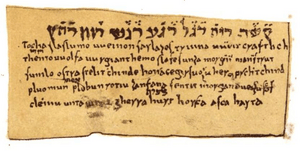Old High German lullaby facts for kids
An Old High German lullaby (which means Althochdeutsches Schlummerlied in German) was first talked about in 1859. A man named Georg Zappert from Vienna, who was a private scholar and collected old books, said he found it. This poem was supposedly from the 10th century and seemed to contain old stories about pre-Christian gods. However, many experts today believe it is a fake created by Zappert himself.
Contents
The Lullaby's Story
Zappert claimed that in 1852, he saw some words in Old High German on a piece of parchment. This parchment was stuck to the spine of a book from the 15th century. He said he bought the book in 1858 so he could carefully remove the parchment. To do this, he had to take the book's binding apart.
Once he got the parchment strip off, Zappert reported that it had an Old High German poem on it. It looked like a lullaby with five lines. He believed the handwriting was from the 9th or 10th century.
Here are the lines Zappert said he found, along with his translation:
- Tocha slafês sliumo / uueinon sar lazzês.
- Translation: "Docke (a sweet name for a child), sleep quickly / stop crying right away."
- Triuua uuerit kraftlicho / themo uuolfa uurgiantemo.
- Translation: "Triuwa (Truth, as a person) strongly / defends against the murdering wolf."
- slafês unz za morgane / manes trût sunilo.
- Translation: "May you sleep until morning / dear son of man."
- Ostârâ stellit chinde / honak egir suozziu.
- Translation: "Ostara (a spring goddess) leaves for the child / honey and sweet eggs."
- Hera prichit chinde / pluomun plobun rotun.
- Translation: "Hera (a goddess) breaks for the child / blue and red flowers."
- Zanfana sentit morgane / ueiziu scaf kleiniu,
- Translation: "Tanfana (another goddess) sends in the morning / little white sheep."
- unta Einouga, herra hurt! / horska aska harta.
- Translation: "and One-Eye (meaning Wotan), master, quickly! / swift, hard spears."
The poem mentions some very interesting things:
- Triuwa: This is like "Truth" acting as a protector.
- Ostara: This is a possible spring goddess. The idea that she leaves eggs for children would be a very old link to easter egg traditions.
- Tanfana: This goddess was only known from very old Roman writings. Finding her name in an Old High German poem would be a huge discovery.
- One-Eye: This name is often used for the god Odin (also called Wotan). If this poem were real, it would be the first time we see Odin called "One-Eye" in West Germanic writings, which matches stories from other parts of Northern Europe.
Before the Old High German text, there was a line of Hebrew words. On the back of the parchment, there was another line of Hebrew. These Hebrew lines seemed to be just practice writing. Zappert thought that maybe an early German Jew, like a rabbi or doctor, wrote the lullaby after hearing it from a wetnurse in their home.
Is It Real or Fake?
If this lullaby were real, it would be an amazing source of information about old Germanic paganism (the beliefs before Christianity). It would tell us even more about these gods than other famous old texts.
When the lullaby was first announced, some scholars had strong opinions:
- Johann Kelle (in 1860) strongly disagreed with Zappert's ideas about the poem's meaning. However, he didn't say it was a fake.
- Jacob Grimm (famous for Grimm's Fairy Tales) seemed to believe it was real. He even wanted to write something to defend it.
But then, a scholar named Grohmann (in 1861) looked at the poem very closely. He wrote a long essay saying that it was clearly a fake. Since Zappert had died in 1859, he couldn't defend his discovery.
Even though some scholars still thought it was real later on, most experts from the late 1800s until today agree with Grohmann. They believe the lullaby is a forgery.
However, the debate isn't completely over. Some scholars in the 20th century still argued that it was real. In fact, out of six essays written about the lullaby in the 20th century, three said it was a fake, and three said it was real. One scholar, Edwards, said that while there's a lot of suspicion, it's not 100% certain that it's a fake.
Arguments for the Lullaby Being Real
- One argument is that the text uses some very specific language knowledge. For example, it uses a special Hebrew mark for a certain "e" sound. Some scholars believe Zappert wouldn't have known this specific linguistic detail at the time, making it harder for him to fake.
Arguments Against the Lullaby Being Real
- Other Forgeries: Zappert is suspected of making other fakes. One old map of Vienna, which he supposedly created, looks very similar in style to the lullaby.
- Ink Analysis: Scientists have looked at the ink used for the lullaby. They found that the ink for the lullaby and one Hebrew line was different from the ink used for other Hebrew words on the parchment. This suggests that the lullaby part might have been added later.
- Zappert's Motive: Zappert was of Jewish background and was very interested in how Germanic and Hebrew cultures might have connected. This strong personal interest could have given him a reason to create a text that showed such a link.
- Matching Grimm's Book: The information about the old gods in the lullaby strangely matches parts of Jacob Grimm's book Deutsche Mythologie (German Mythology), which was first published in 1835. In his book, Grimm often mentioned that he wished there were more old sources about these gods. This makes it seem like Zappert might have looked for "holes" in Grimm's book and tried to "fill" them with his "discovery."


